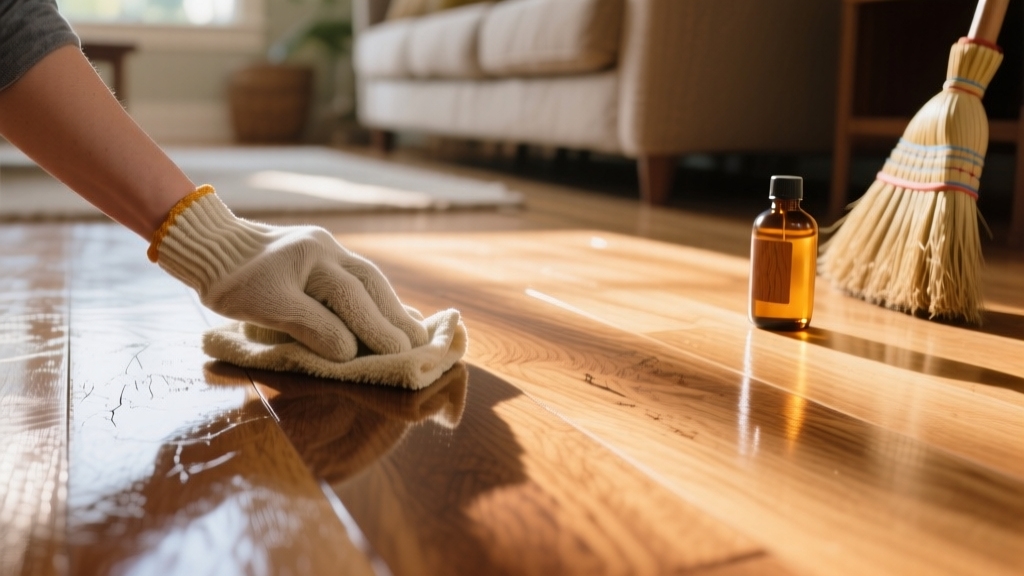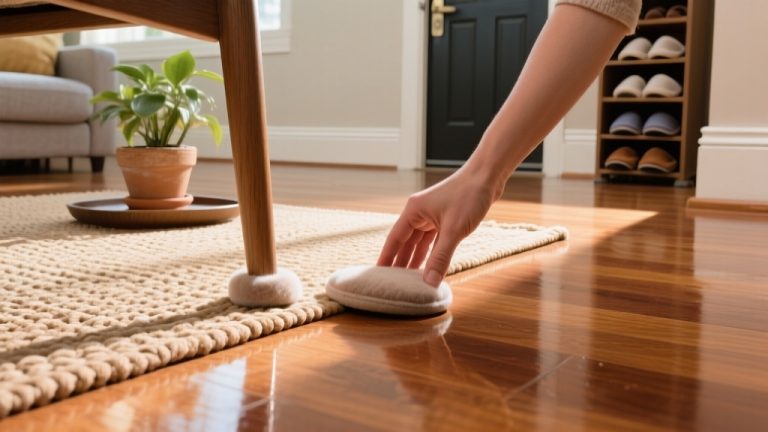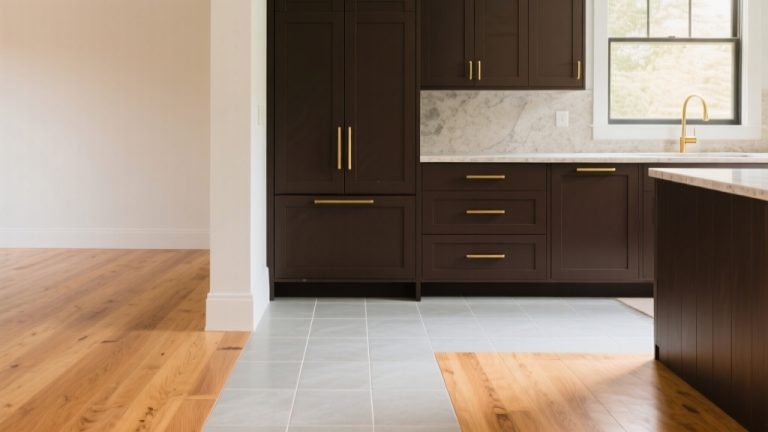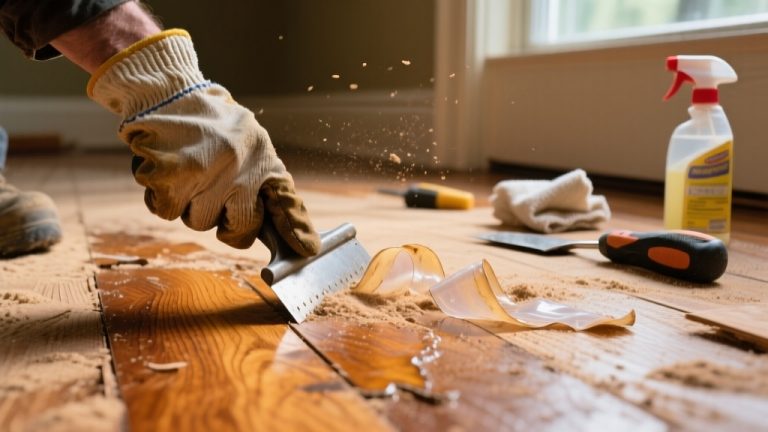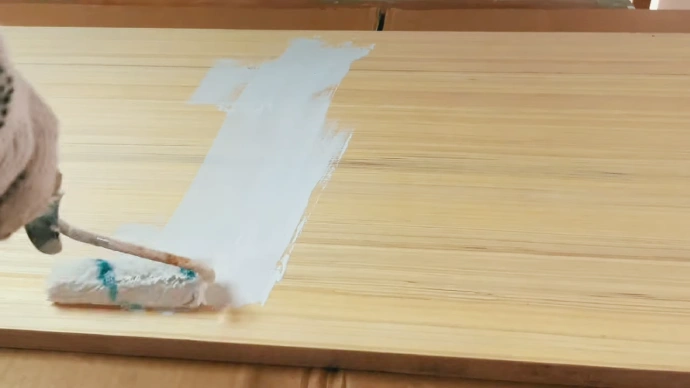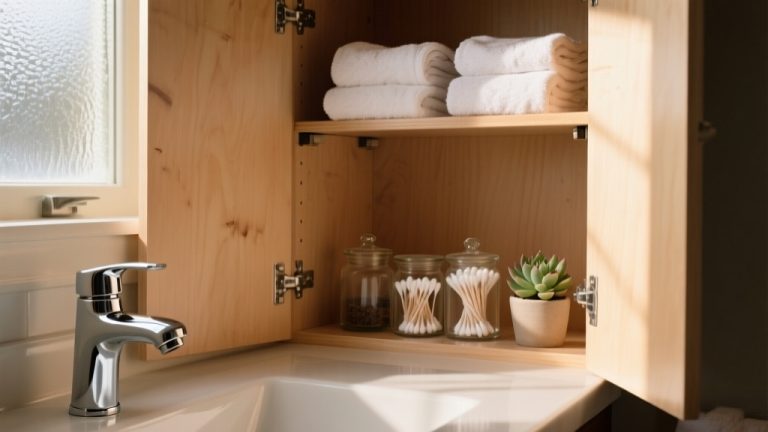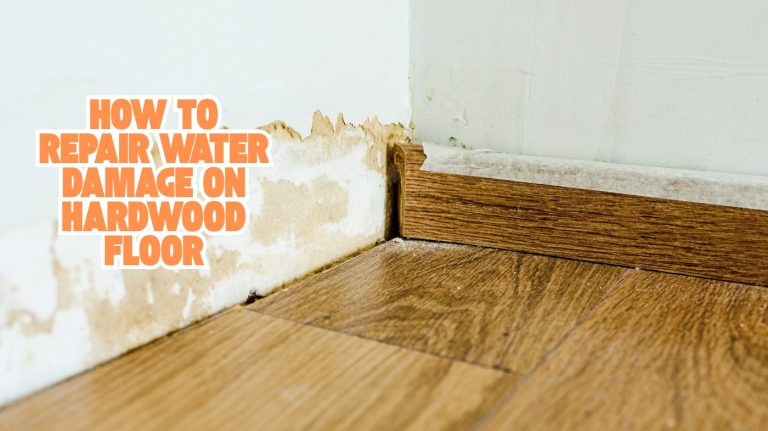How to Maintain a Hardwood Floor: Neutral pH for Safe Shine
You maintain your hardwood floor by sweeping or dust mopping daily to remove dirt and vacuuming weekly with a hard-floor setting. Use a damp mop with a neutral pH cleaner to avoid damage and clean spills immediately.
Control indoor humidity between 35-55% and protect floors with felt pads and entry mats. Regularly apply sealants and inspect for damage. Managing these steps guarantees durability and appearance. Understanding the nuances of each will guide you to expert care.
Key Takeaways
- Sweep or dust mop daily to remove dirt and vacuum weekly with the brush roll off to prevent floor damage.
- Clean spills immediately with a damp cloth and use pH-neutral cleaners for mopping to protect the finish.
- Maintain indoor humidity between 35-55% using humidifiers or dehumidifiers to prevent warping and cracking.
- Attach felt pads to furniture legs and use rugs with non-slip pads to minimize scratches and wear.
- Schedule professional deep cleanings every 3-6 months and regularly apply sealants for long-lasting floor protection.
Regular Cleaning Techniques for Hardwood Floors
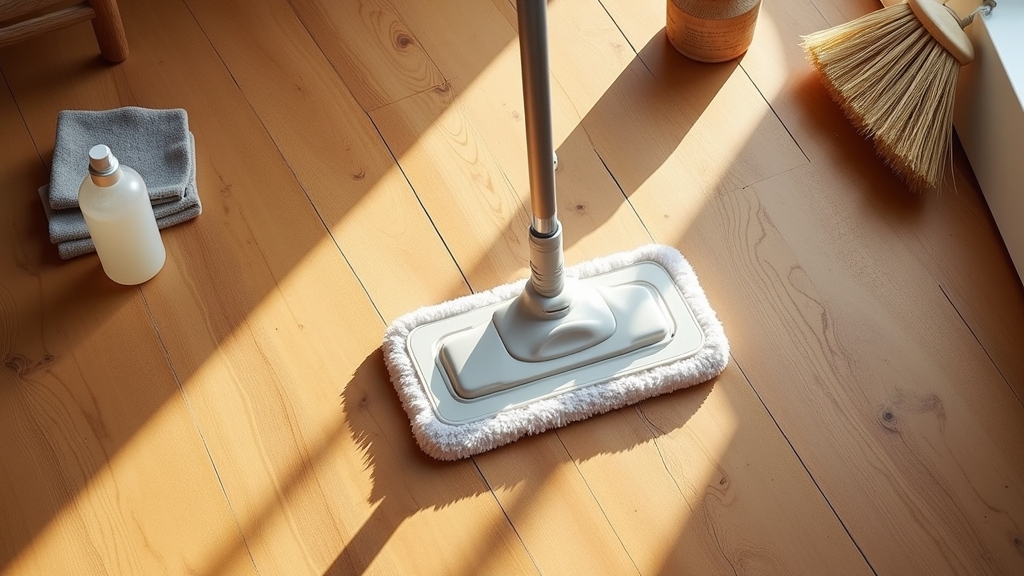
Although hardwood floors are durable, maintaining their appearance and integrity requires consistent cleaning techniques. You should use a microfiber dust mop or broom daily to remove dust and loose dirt, preventing surface scratches. Microfiber dust mop pre-treated with a dusting agent can more effectively pick up dirt and debris.
Vacuum weekly with the brush roll turned off, employing a hard floor setting and rubber-wheeled vacuums to avoid damage. When transitioning between rooms with different flooring, consider installing floor transition strips to protect edges and maintain a smooth surface.
For wet cleaning, use a damp mop with neutral pH hardwood floor cleaners like Bona or Ecolab, avoiding harsh chemicals and ammonia-based products. Wring the mop thoroughly and clean spills immediately to prevent warping.
Employ microfiber mop pads compatible with hardwood floors and avoid steam mops unless manufacturer-approved. Regularly replace mop pads and assess floor condition seasonally. Maintain humidity between 35-55% to minimize wood expansion and contraction, ensuring longevity and preserving finish quality.
Preventative Strategies to Protect Your Floor
When you want to preserve your hardwood floor’s durability and appearance, implementing preventative strategies is essential. Start by applying high-quality protective sealants that create an invisible barrier against moisture, stains, and wear.
Reapply sealants as recommended and inspect them regularly, especially in high-traffic areas. Sealants act as an invisible moisture barrier, protecting hardwood floors from water damage. Regularly sweeping or dusting the floor helps remove dirt and debris that can cause scratches during vacuuming or foot traffic.
Control indoor humidity between 35% and 45% using humidifiers or dehumidifiers to prevent wood expansion or contraction. Attach felt or rubber pads to furniture legs and place rugs with non-slip pads in vulnerable zones to minimize scratches and wear.
Install layered entry mats to trap dirt and moisture, and use UV-filtering window treatments to reduce sun damage. Place rugs in high-moisture zones like entryways and kitchens to further reduce moisture exposure.
Additionally, vacuuming with soft roller cleaner heads designed for hardwood floors can help minimize surface damage. Promptly clean spills with pH-neutral products and dry thoroughly to prevent staining and warping, ensuring your floor remains resilient and visually appealing.
Establishing a Maintenance Routine
Because hardwood floors require regular care to maintain their appearance and durability, establishing a consistent maintenance routine is essential. You should sweep or dust mop daily with a microfiber mop to remove dust and prevent scratches, and wipe spills immediately using a dry or lightly damp cloth.
Once a week, vacuum with the brush roll off and dry mop using a cleaner approved for your floor’s finish. It is important to use appropriate cleaning solutions to avoid finish damage. Monthly, inspect for wear, clean thoroughly, and check furniture pads and mats, replacing or repositioning as needed.
Using protective measures like underlayment can also help extend the floor’s durability and stability. Every three to six months, schedule professional deep cleaning to remove embedded dirt and maintain finish integrity.
Tailor your routine to household activity levels, consistently use protective measures, and monitor floor condition to plan refinishing or re-coating well before damage occurs.
Repairing and Handling Floor Damage
While hardwood floors offer durability and aesthetic appeal, they remain vulnerable to various types of damage such as scratches, dents, water stains, and warping.
Begin by evaluating the damage visually and by touch. Minor scratches can be sanded and refinished, while deep gouges may require board replacement. Recognizing the source and extent of damage is essential for effective restoration planning.
For dents, apply water and heat to swell wood fibers before sanding and refinishing. Address water damage swiftly by removing standing water within 48 hours, stopping the source, and using dehumidifiers to control moisture.
Light stains can be sanded out or treated with mineral oil; severe warping or rot demands board replacement. Using cleaning devices with wet cleaning precautions can help prevent further water damage during maintenance.
Use proper tools—saws, chisels, sandpaper—and wear safety gear. Document damage carefully for repair planning and insurance. Precision in measurement and matching materials ensures seamless repairs.
Seasonal Care and Environmental Adjustments
Although hardwood floors are durable, they require diligent seasonal care and environmental adjustments to maintain their integrity and appearance.
You need to monitor indoor humidity levels, keeping them between 35% and 55% to prevent wood expansion or contraction that causes warping or cracking. Use a humidifier in winter and a dehumidifier or air conditioning in summer to stabilize moisture.
Maintain indoor humidity between 35%-55% to prevent hardwood floors from warping or cracking.
Maintain stable indoor temperatures between 60-80°F and minimize sun exposure with window treatments to prevent fading. Conduct biannual deep cleanings each spring and fall, and apply floor polish in autumn to protect finishes during harsh months.
Use area rugs in high-traffic zones, replace worn mats seasonally, and rotate furniture to distribute wear evenly. Avoid excessive water and harsh chemicals year-round to preserve your hardwood floors effectively. Additionally, consider using furniture pads or coasters under heavy furniture to distribute weight and prevent dents.
Frequently Asked Questions
Can Hardwood Floors Be Installed in Bathrooms or Basements?
You can install hardwood floors in bathrooms or basements, but solid hardwood is risky due to moisture-induced warping and damage. Instead, choose engineered hardwood with proper acclimation, expansion gaps, and moisture barriers.
Guarantee plumbing leaks are fixed, and waterproof seals are applied. In basements, use vapor barriers and dehumidifiers. For better durability and maintenance, consider wood-look tiles or waterproof vinyl as superior alternatives in these moisture-prone areas.
What Types of Wood Finishes Are Best for Durability?
For maximum durability, you’ll want to choose an aluminum oxide finish. It resists scratches, water, and fading for up to 25 years, though it’s only on prefinished floors installed by pros. Acid-cured finishes offer superior wear resistance but need professional application due to strong fumes.
Oil-based polyurethane balances durability and appearance but yellows over time. Water-based polyurethane dries quickly and is safer but less durable, making it ideal for moderate traffic areas.
How Do Pets Affect Hardwood Floor Longevity?
Pets shorten hardwood floor longevity by causing scratches, gouges, and moisture damage. Their nails create surface abrasions that accumulate over time, while accidents like urine penetrate wood, causing permanent stains and warping.
To protect your floor, regularly trim your pet’s nails, clean spills promptly, and consider harder wood species with durable finishes. Neglecting these factors leads to accelerated wear, costly repairs, and reduced aesthetic appeal in your hardwood flooring.
Are There Eco-Friendly Hardwood Floor Cleaning Products?
Imagine you choose an EWG-verified cleaner with plant-based surfactants and biodegradable enzymes that effectively removes scuff marks without harming finishes.
Yes, eco-friendly hardwood floor cleaners exist—they use natural ingredients like peppermint oil and avoid harsh chemicals such as ammonia or formaldehyde.
These products often come in recyclable packaging, are pet-safe, and support septic systems. You can dilute concentrates for economical use, making them both sustainable and practical.
Can Hardwood Floors Be Refinished Multiple Times?
Yes, you can refinish hardwood floors multiple times, but it depends on the wood type and thickness. Solid hardwoods typically allow 5 to 10 refinishing cycles. Engineered hardwoods withstand about 1 to 3 refinishing cycles due to thinner veneers.
Each refinish sands away roughly 1/32 inch. So, you need to monitor wear layer thickness closely to avoid damage. Consulting a professional guarantees you don’t oversand and compromise your floor’s lifespan.
Humidity Control: Hidden Key to Hardwood Floor Protection
You’ll find that consistent cleaning and preventative care transform your hardwood floor from dull and vulnerable to vibrant and resilient. While neglect leaves scratches and stains to accumulate like shadows, regular maintenance brightens and preserves each plank’s natural beauty.
By establishing routines and addressing damage promptly, you create a durable surface that withstands time and seasonal changes. Your hardwood floor, when properly cared for, becomes a lasting foundation of elegance and strength in your home.

